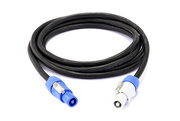
Rule 1 - If you don't know what it does don't touch it.
Rule 2 - See rule one.
Rule 3 - Don't try and fix ANYTHING electrical yourself, go and have a cup of tea and let an electrician do it for you.
Now that thats out of the way, here are some of the most common power related items found in the entertainment industry:
This is a powercon cable. Most moving heads and high end LED fixtures run using a powercon cable. They are good as the connectors twist inside the fixture to lock it in place and so it is very rare for a connector to fall out unless damaged. This is far preferable to standard IEC cables. Lots of fixtures have powercon In/Out and so you can daisy chain power between fixtures, though be careful not to overload your power source. In order to tell if you're going to overload a power source you need to calculate the total power draw of your power line, you can find out how much power a fixture draws in its manual or on the manufacturers website.
There are many ways to distribute power around you rig, though by far the favourite is through the use of distro boxes. Think of these as a kind of extension lead, they save you having to run miles and miles of cable for no reason and also covert your power source into different sized sockets so that you aren't having to use masses of converters. A common input to a 'distro box' would be a 32 Amp socket and it might have 4, 16 Amp outputs on it. When mounting a distro box to a truss it is recommended that you sit it inside the truss (triangular truss) or on top of or inside of box truss, you should then secure it using a suitably rated U bolt.
Generally speaking there are two main types of power source. Three phase and Single phase both with various currents. There are many differences between the two and people have written Phd's on the subject so I'm not going to go into detail. Basically when you see a red socket or plug it is three phase, the plug will have more pins inside of it than a single phase plug. If you read up on anything about three phase let it be phase overloading as this can be very dangerous. Three phase in general is better not messed around with and so you should always be working with someone with very good electrical knowledge when using three phase power and always remember rule one! The production Master Electrician is the person to speak to should you be unsure of anything electrical.
Rule 2 - See rule one.
Rule 3 - Don't try and fix ANYTHING electrical yourself, go and have a cup of tea and let an electrician do it for you.
Now that thats out of the way, here are some of the most common power related items found in the entertainment industry:
This is a powercon cable. Most moving heads and high end LED fixtures run using a powercon cable. They are good as the connectors twist inside the fixture to lock it in place and so it is very rare for a connector to fall out unless damaged. This is far preferable to standard IEC cables. Lots of fixtures have powercon In/Out and so you can daisy chain power between fixtures, though be careful not to overload your power source. In order to tell if you're going to overload a power source you need to calculate the total power draw of your power line, you can find out how much power a fixture draws in its manual or on the manufacturers website.
There are many ways to distribute power around you rig, though by far the favourite is through the use of distro boxes. Think of these as a kind of extension lead, they save you having to run miles and miles of cable for no reason and also covert your power source into different sized sockets so that you aren't having to use masses of converters. A common input to a 'distro box' would be a 32 Amp socket and it might have 4, 16 Amp outputs on it. When mounting a distro box to a truss it is recommended that you sit it inside the truss (triangular truss) or on top of or inside of box truss, you should then secure it using a suitably rated U bolt.
Generally speaking there are two main types of power source. Three phase and Single phase both with various currents. There are many differences between the two and people have written Phd's on the subject so I'm not going to go into detail. Basically when you see a red socket or plug it is three phase, the plug will have more pins inside of it than a single phase plug. If you read up on anything about three phase let it be phase overloading as this can be very dangerous. Three phase in general is better not messed around with and so you should always be working with someone with very good electrical knowledge when using three phase power and always remember rule one! The production Master Electrician is the person to speak to should you be unsure of anything electrical.